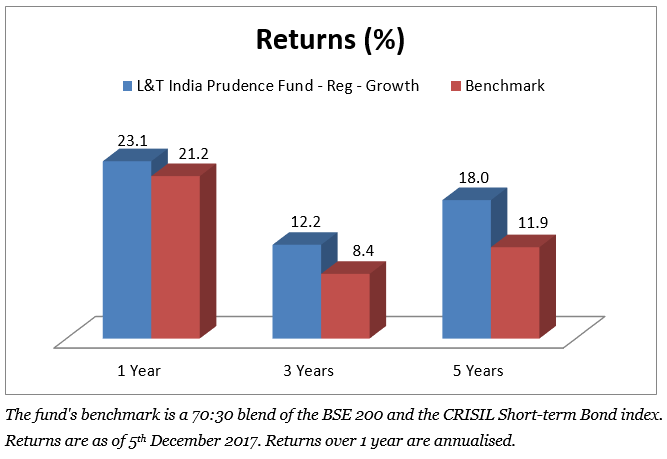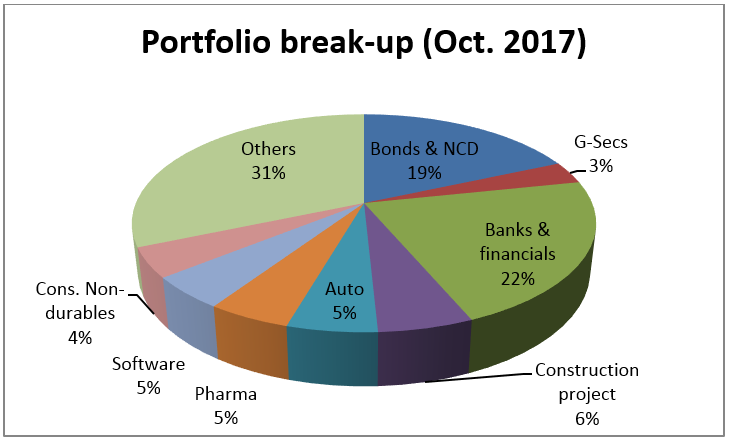What
- A balanced fund that invests 65-75% in equities and the rest in debt
Why
- Ability to beat peers and benchmark across timeframes
- Ability to contain losses better than peers
- Aggressive stock-picking strategy offset by a conservative debt portfolio
Whom
- Any investor with a minimum 3-year horizon
- First-time investors in equity markets
Among balanced funds, L&T India Prudence (L&T Prudence) has for long ranked near the top. Its ability to stay ahead of the balanced pack and the CRISIL Balanced Aggressive index across different timeframes is matched by few. It is able to contain declines better than most peers while also being relatively less volatile. The fund’s mandate caps equity exposure at 75% with the rest in debt, though the fund has generally held a much lower average equity exposure.
L&T Prudence is a good fit for first-time investors who want to enter the equity market – balanced funds generally are less volatile than pure equity funds and also tend to fall to a lesser extent. The fund is also suitable for any investor who wants a lower-risk route to add equity to their portfolios. The fund requires around 3 years or more as an investment horizon.
Performance
L&T Prudence maintained equity exposure at 68% on an average over the past five years. This is on par with HDFC Balanced and much lower than funds such as Tata Balanced or HDFC Prudence. L&T Prudence tends to move equity exposure frequently within a narrow band of 67-71% for the most part and rarely goes higher.
Rolling its 1-year returns over 5 years, the fund has beaten the category average a good 86% of the time which is better than the figures for HDFC Balanced and on par with those such as Aditya Birla Sun Life Balanced 95. Rolling longer 3-year returns for 5 years, the fund has beaten the category average and the CRISIL Balanced Advantage index all the time, pointing to a good record of consistency in outperformance. This consistency figure is matched only by a handful of funds such as HDFC Balanced and ICICI Prudential Balanced. The margin by which the fund beat the category average was a good 3.5 percentage points.
Being launched in January 2011 (it was part of the Fidelity stable), L&T Prudence has not witnessed a sharp correcting market. It managed better than peer average in the sideways 2013 market and in the volatile periods of late 2015 and late 2016. Its worst 1-year return was a loss of 7.6% in February 2016; this loss is among the least when compared with other balanced funds. Most other balanced funds suffered bigger 1-year losses. The 1-year rolling return also shows that L&T Prudence had among the lowest incidence of delivering losses in the balanced category, on par with established funds such as HDFC Balanced, ICICI Prudential Balanced, and Tata Balanced.
L&T Prudence‘s risk-adjusted return, measured by Sharpe, holds above the category average. While it takes quick calls on stocks and shuffles its portfolio frequently, it has still managed to keep volatility in returns below the category’s average.
Strategy and portfolio
In its equity portfolio, L&T Prudence follows a diversified approach, as most balanced funds do. The fund hasn’t cut back on its midcap exposure in the past year, holding it at 15-17% of the portfolio. It pruned small-cap exposure significantly; from about 13% of the portfolio last year to 5% now. The fund tends to take more stock-specific calls rather than an overall sector call. It can also change stock and sector allocations quite quickly. L&T Prudence’s stock-specific approach can work well in any market and specifically in the current one with broad market valuations on the higher side and the lack of strong earnings growth at the aggregate level.
In its sector shifts, the fund added stocks in the infrastructure and construction space quite early on in 2015, maintained allocations throughout 2016 and slowly added to them this year. While banking and financial services hold the heaviest sector weight, their holding has dropped in the past few months in favour of chemicals, pharmaceuticals, and telecom. It is not overboard on consumer-facing sectors such as automobiles or consumer goods.
Its stock calls can get quite offbeat; it does not take concentrated exposures and rarely goes over 5% in any stock. It regularly books profits in or exits stocks that have rallied. With such an approach, timing of entry and exit needs to work well, and in this, L&T Prudence has mostly been adept. It picked up and exited Balrampur Chini Mills, Kajaria Ceramics, Vardhman Textiles, Axis Bank in 2015 and 2016, for example; it bought into Ashok Leyland and Ashoka Buildcon early on and continues to hold these outperformers. It pruned back exposure to multi-bagger stock Future Retail and outperformer Manappuram Finance this year, among other stocks.
On the debt front, L&T Prudence does not get too aggressive. While it did take duration calls when the opportunity was very attractive in 2015, it has scaled back this call this year. Other balanced funds continue to be more aggressive than this on the duration front. L&T Prudence also does not move into papers with lower credit rating as some peers have, and sticks to papers rated AA+ and above. While this may pull down debt yields, it lends safety to the portfolio to counter the aggressive equity approach.
The fund’s AUM is Rs 7,776 crore. S.N. Lahiri, Shriram Ramanathan, and Karan Desai are the fund’s managers.
FundsIndia’s Research team has, to the best of its ability, taken into account various factors – both quantitative measures and qualitative assessments, in an unbiased manner, while choosing the fund(s) mentioned above. However, they carry unknown risks and uncertainties linked to broad markets, as well as analysts’ expectations about future events. They should not, therefore, be the sole basis for investment decisions. To know how to read our weekly fund reviews, please click here.









